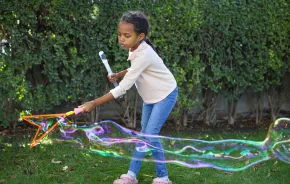Want that birthday party to be a smashing success — without smashing the environment? Along with the happy memories, many parties also leave behind heaps of disposable plates, deflated balloons, torn wrapping paper, packaging and a bunch of new plastic toys your child could probably do without. The waste generated by kids’ parties can be staggering. But there are ways to up the eco-factor without sacrificing a bit of fun.
You don’t have to go to extremes to make a difference. After all, your kid is likely a seasoned guest of traditional birthday parties, and probably thinks that’s what a birthday party is supposed to look like. Imagine your child’s tears if you decide to serve organic yogurt instead of cake. Not every child will fully appreciate your desire to plant a tree in his honor instead of presents.
The trick is to pick a kid-friendly theme, if possible, not a cartoon character (which may result in your child wanting the stuff from the party store). Tiffany Washko, editor of the Web site NatureMoms.com, suggests getting kids involved in creating the theme by making invitations and crafting decorations for the party. Instead of balloons, which may pop and be ingested by wildlife, have kids decorate paper lanterns instead. She suggests making invitations from leftover scraps of paper, using resources you already have in your home. Another option is to send online invitations, or try special seeded paper that your guests can plant to grow wildflowers.
Skip the plastic
Washko recommends using fabric to make your own goody bags, and filling them with homemade finger paints, play dough or soy crayons. “Plastic bags such as those used for party favors can end up just floating around the environment,” says Tom Geiger, spokesman for the Washington Environmental Council. “Always try to avoid plastics if you can. They are harmful to manufacture, since most are petroleum-based, not vegetable-based, and as a result they don’t biodegrade. They just break down into smaller pieces that can be ingested by birds and marine life.”
Geiger explains that one plastic fork used at a birthday party will still be around in our environment for many generations to come. Instead of using the disposable stuff, he recommends going for your own dinnerware. If you don’t have enough for the party, he suggests purchasing one set of plastic plates and utensils and washing them after each party; that way you can use them for years. Another alternative is recyclable unwaxed paper. “In the city of Seattle, we have composting programs that allow you to just throw paper cups and plates into the compost bin with bits of food still on them,” he says. There are also specialty companies, such as Preserve, which make disposable plates and utensils out of materials that will biodegrade.
For drinks, juice boxes may be convenient, but Geiger advises parents to avoid them. “Underneath the paper layers there’s a layer of a nonrecyclable film material that allows [the drink] to not require refrigeration,” Geiger says. “Basically, all you can do with them is just throw them away, since they’re only meant to be a one-time-use product. It’s better to mix up some juice and use paper cups instead.”
As for wrapping paper, Kristin Costello, local mom and founder of the Web site GoingGreenFamily.com, suggests using fabric, newspaper or brown paper grocery bags that kids can paint or color.
Re-use and recycle
“Being green also means reducing consumption and the need for buying so many new toys,” Costello says. “Many families have closets and garages full of old toys and used books. You can ask guests to bring one of their previously loved toys; you can do a book swap; or you can encourage children to make a homemade gift.”
When shopping for your own child, explore garage sales, consignment stores or thrift stores to cut down on the number of plastic toys that end up in landfills. For new toys, try choosing those that are more sustainable, such as toys made of wood or special corn-based biodegradable plastics.
Some families decide to forgo gifts altogether, choosing to donate to a charitable cause instead. “One of my favorite birthday party ideas is to throw an animal-themed party and donate to The Humane Society,” Washko says. On the invitation, you can ask guests to bring pet food, collars, dog toys and blankets. Then after the cake, guests can have a tour of the local animal shelter, and the kids can drop off their donations.
Washko says, “Having a green birthday party is a great way to teach children at a young age that our actions have consequences. It shows them we have to make decisions, even on special occasions, that have a positive impact on our planet.”
Katie Amodei is a freelance writer, mother and stepmother who lives in Lynnwood.









